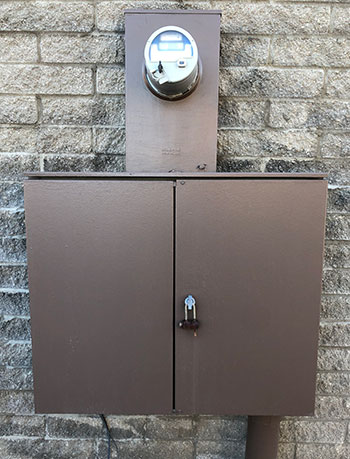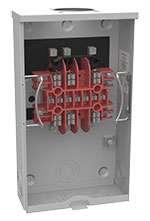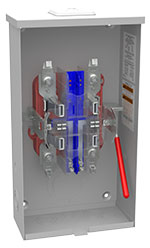Need a CT Meter Socket? Here’s What You Should to Know

A Milbank CT meter socket attached to a transformer in Louisville, Ken.
There are meter sockets on just about every building you pass, and for the houses in your neighborhood, most of those are going to be typical residential self-contained meter socket metering options. But when it comes to businesses and applications that require a larger amperages or higher voltages (typically 480 VAC), you might find CT cabinets and CT meter sockets.
This article will give an overview on what CT meter sockets are, why and how they’re used and some of the different options available or required by certain utilities.
An Introduction to CTs
A CT rated meter socket carries an induced current, reducing the amperage of the current running through the meter. This is done through the use of current transformers, or CTs, which measure alternating current and produce a secondary current in phase with its primary current in a predetermined ratio.
A load conductor passes through the center to induce a current into the windings of the transformer. This induced current is then carried through a secondary circuit loop to a CT rated meter socket housing a CT rated watt-hour meter, which measures the ratio of power used by the customer.
There are two styles of CTs generally used in conjunction with Milbank CT Cabinets and CT rated meter sockets. The first is a window type CT—also known as a doughnut type CT—which includes a space in the center of the CT for the wire or bussing to pass through. This style is commonly found in CT cabinets or mounted to buildings or power poles.
The second kind is a bar type CT, also used commonly with Milbank CT rated meter socket installations. Bar type CTs come from the factory with in-line bussing or conductor attached to the CT and typically connects the line and load conductors in a CT cabinet or rack. In this scenario, each end of the bar type CT has landing pads to attach to. The same landing pads are the locations where incoming line conductors and outgoing load conductors land. The bar type style helps eliminate tight bends in cables with large conductors and makes direction changes easier for load conductors. It can allow for a smaller cabinet sizes, taking up less space.
When to Use a CT Meter Socket
Utilities will often require CTs once an application reaches a certain amperage or voltage. For EUSERC (Electric Utility Service Equipment Requirements Committee) out west, that means going to CTs for applications above 200 Amps. Other areas typically require CTs for application over 400 Amps. Both of these are at voltages of 480.
The biggest reason behind this is safety for the workers who service and replace meters. Applications are typically commercial and industrial, but it’s always best to consult the utility to ensure their requirements are being met for the installation (meter form, correct meter socket, internal wiring colors and configurations, etc.).
CT meter sockets are often used in conjunction with a CT cabinet—both items are either mounted separately or in some cases, the socket is mounted on the cabinet itself. In certain areas, such as the parts of the American Southwest, utilities might call for a transocket, where both the meter socket and CT section are housed inside a single enclosure.
In cases where power distribution is needed for large projects such as EV charging or park lighting, Milbank Power Distribution & Controls can house the power distribution and can also come equipped with CT meter sockets.
Test Switches and Other Options
In CT rated applications, utilities often specify test switch and wiring color and configuration requirements. Test switches are used for shunting and for testing the CTs.
switches are used for shunting and for testing the CTs.
Milbank CT meter sockets can come with provisions for field-installable test switches or ones that come installed from the factory. If given a wiring diagram that specifies the necessary utility configuration and meter form, Milbank can develop custom-prewired CT rated meter sockets.
There are several other features a utility might specify for CT meter sockets and CT cabinets. One is a provision for either PTs or a VT pack. PTs or voltage transformers reduce the voltage running through a meter socket, providing additional safety for  workers.
workers.
Bypass options for CT meter sockets can vary. An auto bypass, or plunger bypass, feature means when the CT meter is pulled out of the socket, the CTs are automatically shunted. A test switch is typically not used in conjunction with auto bypass sockets but can be if specified by the utility. Milbank also offers CT rated meter sockets with heavy duty lever bypass including the U4490-XL shown here.
Milbank offers a range of CT meter sockets with the different features mentioned above available. One common option is the UC7237-RL, a 13 terminal ringless meter socket. Download our Instrument Rated catalog to see more options.
If you’re interested in receiving future product information and updates from Milbank, consider subscribing to our update list!